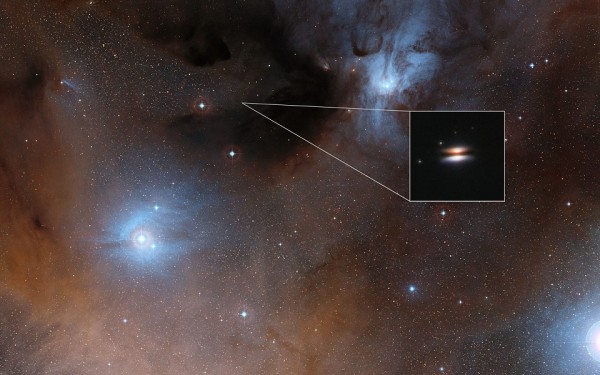By Ana Verayo, | February 04, 2016

The young star 2MASS J16281370-2431391 lies in the spectacular Rho Ophiuchi star formation region, about 400 light-years from Earth.
Astronomers have found a young star surrounded by a protoplanetary disk containing extremely frigid particles that are so cold, where scientists are baffled since this does not match with any current planet formation models.
This baby star is known as 2MASS J16281370-2431391, which is located some 400 light years away from Earth, in the Rho Ophiuchi region, which is also a stellar nursery. This unusual young star is revealing a remarkable protoplanetary disk, with a glowing halo but with a dark band in the middle, that astronomers find extremely intriguing.
Like Us on Facebook
This baby star's protoplanetary disk looks like a flying saucer appearing in retro science fiction comics, as astronomers dub this disk as the "Flying Saucer". Using the ALMA telescope ( Atacama Large Millimeter/submillimeter Array) in Chile along with the IRAM 30 meter telescope in Spain, scientists investigated this odd feature that shows dust on the edges of the disk.
According to lead author of the study, Stephane Guilloteau of the Laboratoire d'Astrophysique de Bordeaux, France, the disk is not observed with a black and empty night sky as its background but it has been viewed in silhouette, where the Rho Ophiuchi Nebula glows in front of it. This glow was too extended for ALMA to detect it, so the disk absorbs it, resulting in a negative signal, suggesting that parts of the disk are colder than its background.
This also means that Earth, is enveloped by the shadow the Flying Saucer.
The team obtained direct measurements from the huge grains of dust inside the Flying Saucer, measuring one millimeter across, which is located some 9 billion miles away from the star. They discovered that this dust is suspended in an extremely cold environment of -266 degrees Celsius.
These grains are part of planetary material used to create planets as the system develops, however, current models predict that these dust particles should be at least -258 to -253 degrees Celsius above zero. It is still cold, but the temperatures discrepancy is remarkable.
According to co-author of the study, Emmanuel di Folco, from the Laboratoire d'Astrophysique de Bordeaux, this discovery can now lead to more valuable data about dust particle properties in such low temperatures that could depend on grain size as bigger ones are cooler than smaller ones.
This also means that planets could form differently when protoplanetary particles have different temperatures. For example, cooler dust can form larger planets closer to their parent star.
-
Use of Coronavirus Pandemic Drones Raises Privacy Concerns: Drones Spread Fear, Local Officials Say

-
Coronavirus Hampers The Delivery Of Lockheed Martin F-35 Stealth Fighters For 2020

-
Instagram Speeds Up Plans to Add Account Memorialization Feature Due to COVID-19 Deaths

-
NASA: Perseverance Plans to Bring 'Mars Rock' to Earth in 2031

-
600 Dead And 3,000 In The Hospital as Iranians Believed Drinking High-Concentrations of Alcohol Can Cure The Coronavirus

-
600 Dead And 3,000 In The Hospital as Iranians Believed Drinking High-Concentrations of Alcohol Can Cure The Coronavirus

-
COVID-19: Doctors, Nurses Use Virtual Reality to Learn New Skills in Treating Coronavirus Patients







